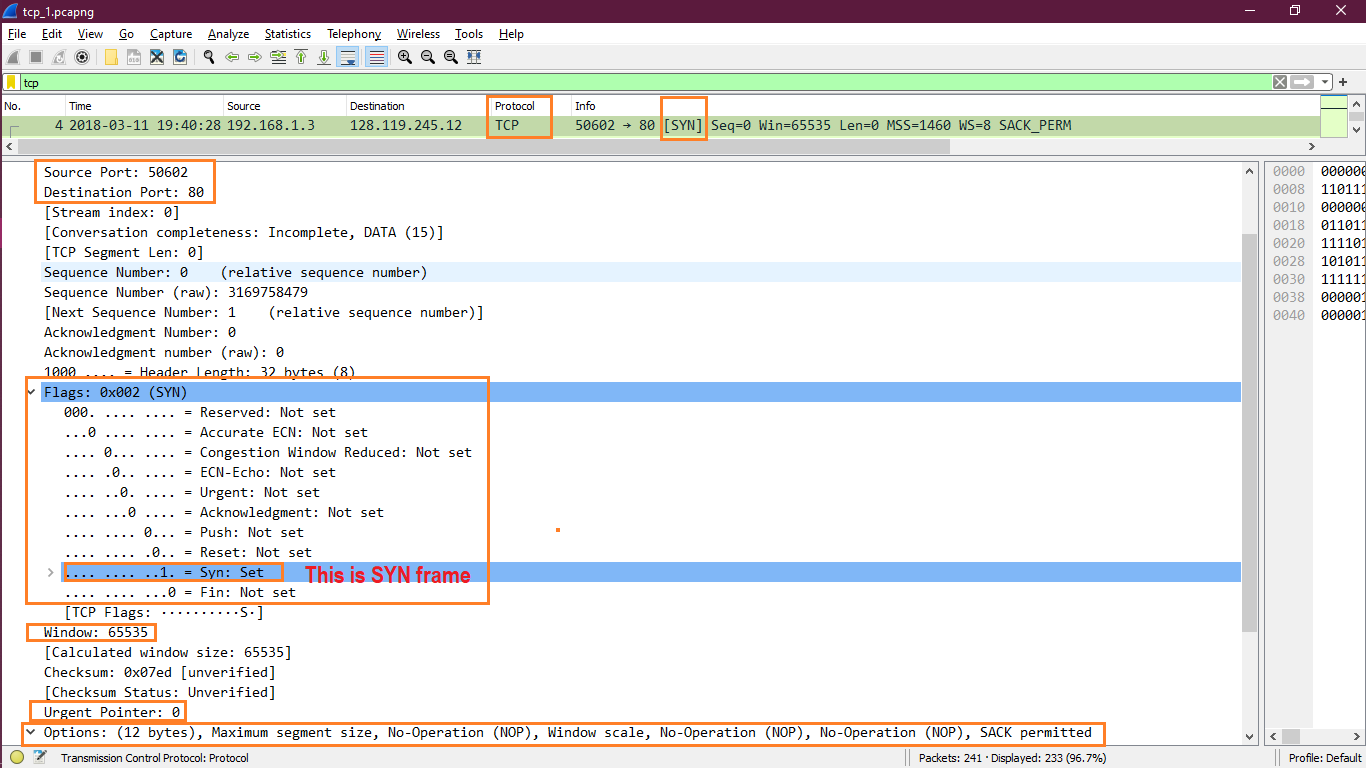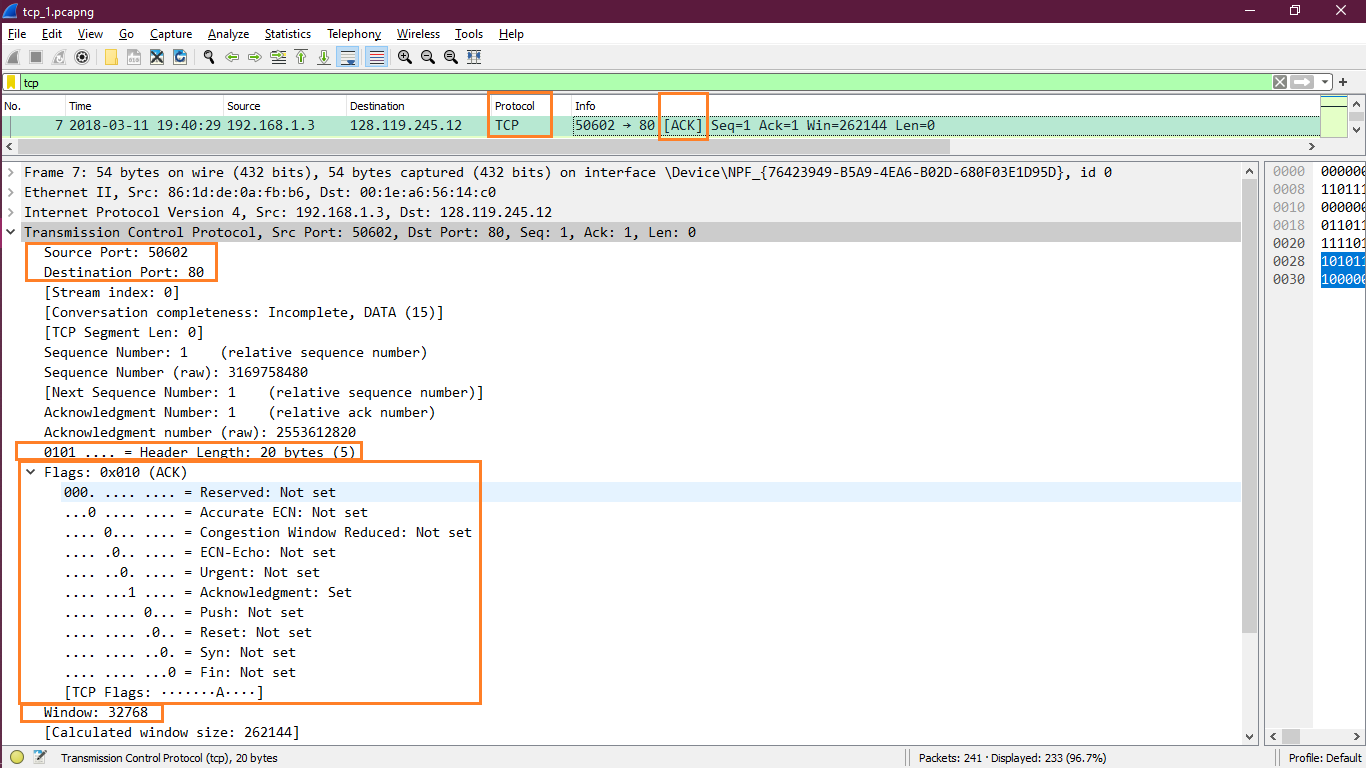Transmission Control Protocol is a very important protocol in transport layer for OSI or TCP/IP model. There are many advantages in TCP like:
- TCP does re-transmission if any sent data is not acknowledged by the receiver within some time.
- TCP establishes some connection before sending the data. We call that connection as 3-way handshake.
- TCP has congestion control mechanism.
- TCP can detect error using some methods.
Let us learn mainly on TCP 3-way handshake. Let’s also learn about the important fields in Wireshark for 3-way handshake.
3-Way Handshake
There are three frames exchanges that happen in a 3-way handshake:
The first frame is always sent by the client to the server. Let us understand this from a simple diagram:
“CLIENT” “SERVER”
<-------------------------------------------Server sends SYN+ACK frame to client: Frame2
Frame3: Client sends ACK frame to server----------------------------------->
We can see these three frames in Wireshark. The “tcp” filter can be used in Wireshark to see all TCP frames. Here is the screenshot for the three frames:
Let us now understand all three frames in details:
SYN
This frame contains many information about the client’s capabilities to inform the server. The following screenshot shows all the important fields of the SYN frame:
Here are the important fields for the SYN frame:
Destination Port: 80
Sequence Number: 0
Acknowledgment Number: 0
Header Length: 32 bytes
Flags: 0x002 (SYN):
Acknowledgment: Not set
Push: Not set
Reset: Not set
Syn: Set -----> This bit set because this is an SYN frame.
Fin: Not set
Window: 65535
Urgent Pointer: 0
TCP Option - Maximum segment size: 1460 bytes
TCP Option - Window scale: 3 (multiply by 8)
TCP Option - SACK permitted
SYN+ACK
This frame contains many information about the server’s capabilities to inform the client. The following screenshot shows all the important fields of the SYN+ACK frame:
This frame also acknowledges the SYN frame that is sent by the client.
Here are the important fields for the SYN+ACK frame:
Destination Port: 50602
Sequence Number: 0
Acknowledgment Number: 1
Header Length: 32 bytes (8)
Flags: 0x012 (SYN, ACK)
Acknowledgment: Set
Push: Not set
Reset: Not set
Syn: Set
Fin: Not set
Window: 29200
Urgent Pointer: 0
TCP Option - Maximum segment size: 1412 bytes
TCP Option - SACK permitted
TCP Option - Window scale: 7 (multiply by 128)
We can see that “Acknowledge” and “SYN” bits are set in this frame. This is because this frame is SYN+ACK.
ACK
This frame is the last frame of the 3-way handshake and also the acknowledgement of the SYN+ACK by the client. The following screenshot shows all the important fields of the ACK frame:
Here are the important fields for the ACK frame:
Destination Port: 80
Sequence Number: 1
Acknowledgment Number: 1
Header Length: 20 bytes (5)
Flags: 0x010 (ACK)
Urgent: Not set
Acknowledgment: Set
Push: Not set
Reset: Not set
Syn: Not set
Fin: Not set
Window: 32768
Here, only the “Acknowledge” bit is set because this is an ACK frame.
Explanation for Some Important Common Fields
Port 80: We observed one fixed port 80 in this tutorial. It’s because this is an HTTP capture and port 80 is fixed (server side) for HTTP communication.
Sequence Number: The sequence number of that frame. Sync is the first frame so we have 0 as a sequence number.
TCP Flags:
Acknowledgement – This bit is set if the frame is an ACK. Example: SYN+ACK, ACK frame.
SYN – This bit is set if the frame is a SYN. Example: SYN.
Window: This field shares the sender’s max window size in receive mode. Example: We have the window size of 65535 bytes in the SYN frame. This means that the receiver can receive a maximum TCP data of 65535 bytes at any point of time.
SACK Permitted: This bit is set if send supports SACK [selective acknowledgement].
Maximum Segment Size: We can also call it MSS. This defines the maximum data frame that the sender can receive. Example: We get MSS as 1460 bytes in the SYN frame.
Conclusion
We learned about the TCP 3-way handshake and all the useful fields for SYN, SYN+ACK, and ACK frames. If you want to learn more on TCP, you can follow this RFC link https://tools.ietf.org/html/rfc793.




